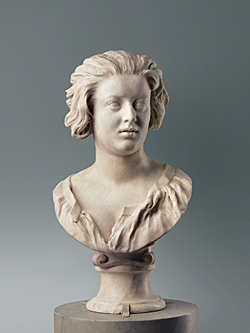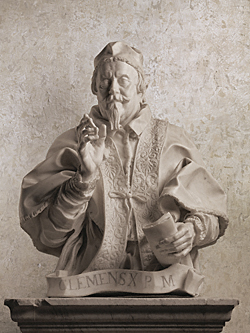|
Gian Lorenzo Bernini (Italian, 1598–1680) and his contemporaries in Rome transformed the portrait bust into a groundbreaking art form. With dazzling virtuosity, these artists were able to coax the living presence and personality of their sitters—creating a "speaking likeness"—from the intractable medium of stone.
Bernini is frequently credited with inventing Baroque art and, throughout his long life, remained its greatest exponent. Celebrating Baroque sculpture, paintings, and drawings, this major international loan exhibition brings together nearly 60 works from both public and private collections, and is the first important exhibition on Bernini in North America.
|
 |

 |
 |
Portrait of Costanza Bonarelli, Gian Lorenzo Bernini, 1636–38
|
 |
 |
Baroque, the European artistic style of the 1600s, targeted the senses using virtuosity and realism, reaching the mind through emotion rather than reason. The term Baroque was coined in the 1700s from the Portuguese word for an irregular pearl, barroco, suggesting the work was composed of distorted forms of histrionic subjects. Baroque art has qualities of theatricality, movement, and exuberance. Artists—like others of the time who were interested in studying, understanding, and recording the world—applied their faculties of keen observation to render details of the physical world and of human psychology.
Bernini's work embodies the quintessence of Baroque energy and dynamism, often capturing a fleeting action in an instant. This bust of Costanza Bonarelli marks the culmination of Bernini's experimentation in presenting immediate, informal, and lifelike portraits. Art historian Rudolf Wittkower, who revived interest in Bernini, called the bust "one of the most remarkable portrait busts of the whole history of art."
|
 |
 |

 |
 |
Portrait of Urban VIII Barberini, Gian Lorenzo Bernini, about 1658
|
 |
The Barberini was the most important family in Rome during the Baroque period. Members of this family attained positions of great authority within the Catholic Church and became great patrons of the arts. Their support was critical to the development of the Baroque style in Rome. This exhibition includes a number of portrait busts by Bernini, and other artists, of the Barberini family members and their court.
Included in the exhibition are several busts of Pope Urban VIII Barberini by Bernini. A man of great erudition and culture, Urban VIII surrounded himself with artists and patronized art on a grand scale. He engaged Bernini in important commissions, the most significant of which was the project to decorate Saint Peter's Basilica in the Vatican, a prestigious undertaking that took 10 years to complete. He also commissioned Bernini to sculpt portrait busts of himself and many of his family members, several of which are on view in this exhibition.
|
 |

 |
 |
Portrait of Pope Clement X Altieri, Gian Lorenzo Bernini, 1676–77
|
 |
 |
Many of Bernini's sculptures are scattered throughout Rome, in churches, palaces, city squares, and local architecture. Once he became involved in large-scale architectural projects, Bernini's time for the less celebrated endeavor of portrait sculpture was limited to accepting commissions from only the most important of patrons. His portrait busts from this period include this sculpture of Pope Clement X, originally placed in a high niche in a library, surrounded by a theatrical swath of stucco "drapery."
Bernini's later portraits may be fewer but they are commanding, ostentatious, and heroic—qualities that were certainly suitable to his regal and papal subjects. Included in this exhibition are Bernini's portraits of Cardinal Richelieu of France, Charles I of England, Pope Alexander VII, and King Louis XIV of France.
This exhibition was organized by the J. Paul Getty Museum and the National Gallery of Canada, Ottawa, and is supported by an indemnity from the Federal Council on the Arts and the Humanities. The Getty Museum is also grateful for the support of the Los Angeles offices of the Italian Consul General and the Italian Cultural Institute in realizing this exhibition.
|
 |
|
 |
|